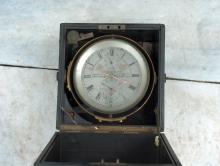Chronometer Weichert, serial No 2355
DETERMINATION OF LONGITUDE AT SEA:
Naval chronometers, octant and sextant
Naval chronometers and the sextant were necessary instruments to determine the longitude where the ship was sailing at a particular moment. Longitude was calculated as the difference between the time of the observed passage of a celestial body from the ship's meridian and the time when the celestial body at hand should cross the reference meridian, according to astronomy tables (reference to the meridian of the Greenwich observatory became global in 1884). This became possible from the moment when chronometers were manufactured with the required precision, so that these could maintain the time of the reference meridian when en route.
Naval chronometers are placed in a specific holder so that they are protected against humidity and can be read through a glass surface, without having to open the holder. When located in the holder, they can freely rotate around two axes, so that they are always horizontal.
In 1731, John Hadley (England) and Thomas Godfrey (Philadelphia) individually produced a scientific instrument for angular measurements through the double reflection method. This instrument was the predecessor of the octant and later of the sextant.
The frame of the octant, shaped as a circular section of approximately 45 degrees, comprises of a static reflector glass dial which is silver plated on half of its surface. A moving ruler is fitted with a second reflector.
Observer uses the sight of the instrument to aim at the horizon, he then moves the ruler so that the image of the celestial body -- sent to the fixed dial by the moving reflector-- coincides with the horizon viewed through the non silver plated surface of the reflector. The angular difference between the ruler and the sight is the angular distance of the star from the horizon.

